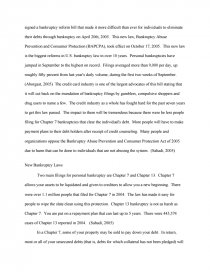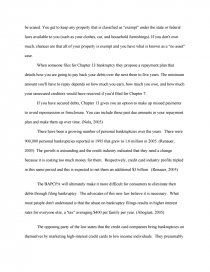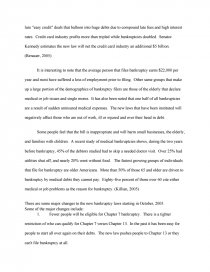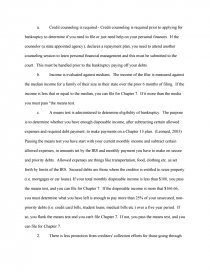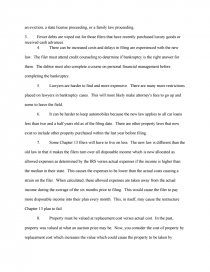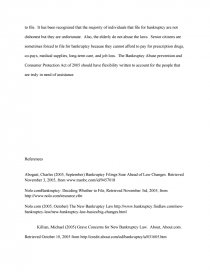New Bankruptcy Laws
Essay by review • February 11, 2011 • Research Paper • 2,250 Words (9 Pages) • 1,494 Views
New Bankruptcy Laws
Abstract
Bankruptcy is a federal court process designed to help consumers and businesses eliminate their debts or repay them under the protection of the bankruptcy court. Bankruptcies can generally be described as "liquidations" or "reorganizations." (Nolo, 2005) President Bush signed a bankruptcy reform bill that made it more difficult than ever for individuals to eliminate their debts through bankruptcy on April 20th, 2005. This new law, Bankruptcy Abuse Prevention and Consumer Protection (BAPCPA), took effect on October 17, 2005. This new law is the biggest reforms in U.S. bankruptcy law in over 10 years. Personal bankruptcies have jumped in September to the highest on record. Filings averaged more than 9,000 per day, up roughly fifty percent from last year's daily volume, during the first two weeks of September. (Aborgast, 2005) The credit card industry is one of the largest advocates of this bill stating that it will cut back on the inundation of bankruptcy filings by gamblers, compulsive shoppers and drug users to name a few. The credit industry as a whole has fought hard for the past seven years to get this law passed. The impact to them will be tremendous because there were be less people filing for Chapter 7 bankruptcies that clear the individual's debt. More people will have to make payment plans to their debt holders after receipt of credit counseling. Many people and organizations oppose the Bankruptcy Abuse Prevention and Consumer Protection Act of 2005 due to harm that can be done to individuals that are not abusing the system. (Sahadi, 2005)
New Bankruptcy Laws
Two main filings for personal bankruptcy are Chapter 7 and Chapter 13. Chapter 7 allows your assets to be liquidated and given to creditors to allow you a new beginning. There were over 1.1 million people that filed for Chapter 7 in 2004. The law has made it easy for people to wipe the slate clean using this protection. Chapter 13 bankruptcy is not as harsh as Chapter 7. You are put on a repayment plan that can last up to 5 years. There were 445,574 cases of Chapter 13 reported in 2004. (Sahadi, 2005)
In a Chapter 7, some of your property may be sold to pay down your debt. In return, most or all of your unsecured debts (that is, debts for which collateral has not been pledged) will be erased. You get to keep any property that is classified as "exempt" under the state or federal laws available to you (such as your clothes, car, and household furnishings). If you don't own much, chances are that all of your property is exempt and you have what is known as a "no asset" case.
When someone files for Chapter 13 bankruptcy they propose a repayment plan that details how you are going to pay back your debts over the next three to five years. The minimum amount you'll have to repay depends on how much you earn, how much you owe, and how much your unsecured creditors would have received if you'd filed for Chapter 7.
If you have secured debts, Chapter 13 gives you an option to make up missed payments to avoid repossession or foreclosure. You can include these past due amounts in your repayment plan and make them up over time. (Nola, 2005)
There have been a growing number of personal bankruptcies over the years. There were 900,000 personal bankruptcies reported in 1995 that grew to 1.6 million in 2005. (Renauer, 2005) The growth is astounding and the credit industry indicated that they need a change because it is costing too much money for them. Respectively, credit card industry profits tripled in this same period and this is expected to net them an additional $5 billion. (Renauer, 2005)
The BAPCPA will ultimately make it more difficult for consumers to eliminate their debts through filing bankruptcy. The advocates of this new law believe it is necessary. What most people don't understand is that the abuse on bankruptcy filings results in higher interest rates for everyone else, a "tax" averaging $400 per family per year. (Abograst, 2005)
The opposing party of the law states that the credit card companies bring bankruptcies on themselves by marketing high-interest credit cards to low income individuals. They presumably lure "easy credit" deals that balloon into huge debts due to compound late fees and high interest rates. Credit card industry profits more than tripled while bankruptcies doubled. Senator Kennedy estimates the new law will net the credit card industry an additional $5 billion. (Renauer, 2005)
It is interesting to note that the average person that files bankruptcy earns $22,000 per year and most have suffered a loss of employment prior to filing. Other same groups that make up a large portion of the demographics of bankruptcy filers are those of the elderly that declare medical or job issues and single moms. It has also been noted that one half of all bankruptcies are a result of sudden uninsured medical expenses. The new laws that have been instituted will negatively affect those who are out of work, ill or injured and over their head in debt.
Some people feel that the bill is inappropriate and will harm small businesses, the elderly, and families with children. A recent study of medical bankruptcies shows, during the two years before bankruptcy, 45% of the debtors studied had to skip a needed doctor visit. Over 25% had utilities shut off, and nearly 20% went without food. The fastest growing groups of individuals that file for bankruptcy are older Americans. More than 50% of those 65 and older are driven to bankruptcy by medical debts they cannot pay. Eighty-five percent of those over 60 cite either medical or job problems as the reason for bankruptcy. (Killian, 2005)
There are some major changes to the new bankruptcy laws starting in October, 2005.
Some of the major changes include:
1. Fewer people will be eligible for Chapter 7 bankruptcy. There is a tighter restriction of who can qualify for Chapter 7 verses Chapter 13. In the past it has been easy for people to start all over again on their debts. The new law pushes people to Chapter 13 or they can't file bankruptcy at all.
a. Credit counseling is required - Credit counseling is required prior to applying for bankruptcy to determine
...
...

